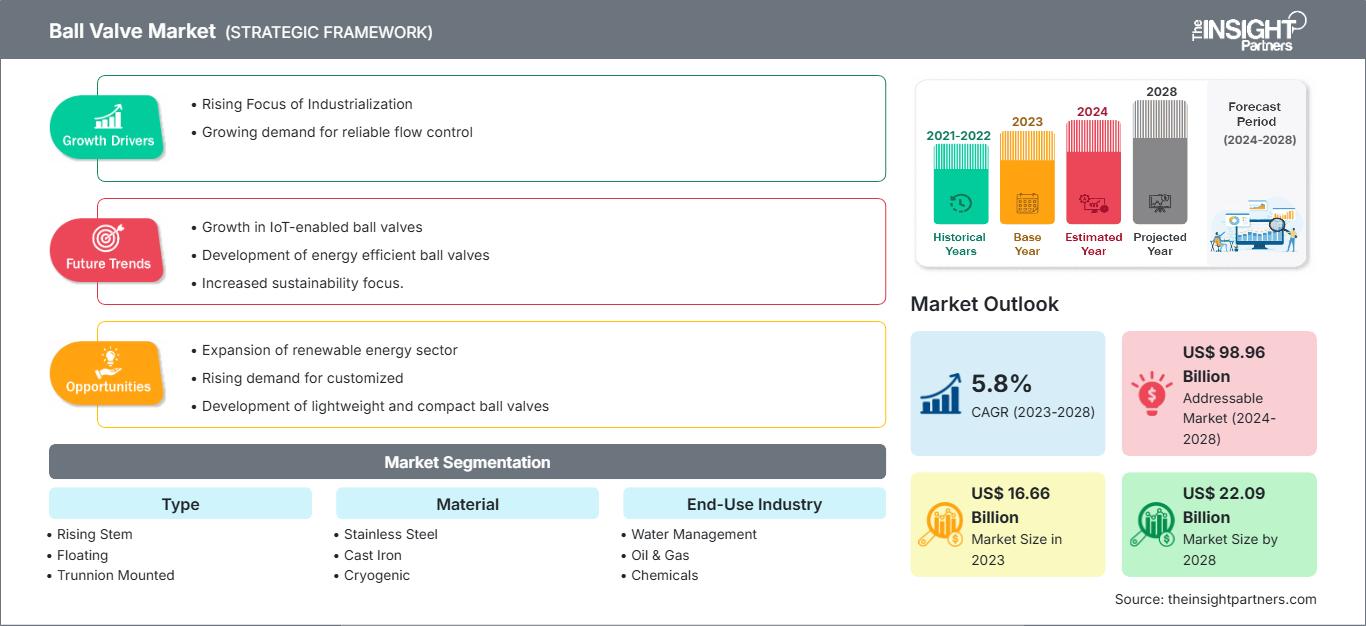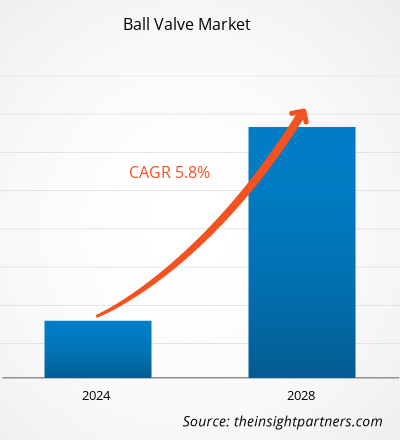[Forschungsbericht] Der Markt für Kugelhähne soll von 16,66 Milliarden US-Dollar im Jahr 2023 auf 22,09 Milliarden US-Dollar im Jahr 2028 anwachsen und zwischen 2023 und 2028 eine durchschnittliche jährliche Wachstumsrate (CAGR) von 5,8 % verzeichnen.
Analystenperspektive:
Der Markt für Kugelhähne ist eine florierende Branche, die in verschiedenen Sektoren eine entscheidende Rolle spielt, darunter Öl und Gas, Wasser- und Abwasseraufbereitung, chemische Verarbeitung, Pharmazeutika, Stromerzeugung und viele andere. Kugelhähne sind mechanische Geräte, die den Durchfluss von Flüssigkeiten durch eine Rohrleitung oder ein System mithilfe einer rotierenden Kugel mit einem Loch darin steuern. Sie bieten hervorragende Absperreigenschaften, einen geringen Wartungsaufwand und eine hohe Haltbarkeit, was sie in vielen Anwendungen beliebt macht. Der Markt für Kugelhähne hat in den letzten Jahren eine erhebliche Entwicklung erlebt, die von mehreren Faktoren getrieben wurde. Einer der Haupttreiber ist die steigende Nachfrage nach Energieressourcen, insbesondere in Schwellenländern. Insbesondere die Öl- und Gasindustrie hat maßgeblich zum Wachstum des Kugelhahnmarktes beigetragen. Kugelhähne werden häufig in Pipelines, Raffinerien und Offshore-Plattformen eingesetzt, um den Öl- und Gasfluss zu regulieren und so einen effizienten Betrieb und Sicherheit zu gewährleisten. Der zunehmende Fokus auf Infrastrukturentwicklung und Industrialisierung hat auch die Nachfrage nach Kugelhähnen in der Wasser- und Abwasseraufbereitung, der Stromerzeugung und der chemischen Verarbeitung angekurbelt. Kugelhähne bieten eine zuverlässige und effiziente Durchflussregelung, die für einen reibungslosen Betrieb dieser Branchen unerlässlich ist. Der Markt hat auch technologische Fortschritte erlebt, wobei Hersteller innovative Designs und Materialien einführten, um die Leistung und Effizienz von Kugelhähnen zu verbessern. So hat beispielsweise die Entwicklung von Materialien wie Edelstahl und Legierungen die Haltbarkeit und Korrosionsbeständigkeit von Kugelhähnen verbessert und ihre Anwendungsmöglichkeiten in anspruchsvollen Umgebungen erweitert. Darüber hinaus hat das wachsende Umweltbewusstsein und der Bedarf an nachhaltigen Lösungen zur Einführung von Kugelhähnen in Bereichen der grünen Energie wie Solar- und Windkraft geführt. Diese Ventile helfen, den Flüssigkeitsfluss in diesen Systemen zu steuern, sorgen für optimale Effizienz und minimieren Energieverluste.
Marktübersicht:
Ein Kugelhahn ist ein Vierteldrehventil mit einer hohlen, perforierten und schwenkbaren Kugel zur Steuerung des Durchflusses. Der Hahn ist geöffnet, wenn sich die Bohrung der Kugel in der Durchflussleitung befindet; wenn der Griff die Bohrung um 90 Grad dreht, ist der Hahn geschlossen. Außerdem ist der Griff im geöffneten Zustand senkrecht, flach ausgerichtet und geschlossen. Kugelhähne haben eine lange Lebensdauer, sind zuverlässig, schließen sicher und funktionieren auch nach längerer Inaktivität noch einwandfrei.
Passen Sie diesen Bericht Ihren Anforderungen an
Sie erhalten kostenlos Anpassungen an jedem Bericht, einschließlich Teilen dieses Berichts oder einer Analyse auf Länderebene, eines Excel-Datenpakets sowie tolle Angebote und Rabatte für Start-ups und Universitäten.
Kugelhahnmarkt: Strategische Einblicke

- Holen Sie sich die wichtigsten Markttrends aus diesem Bericht.Dieses KOSTENLOSE Beispiel umfasst Datenanalysen, die von Markttrends bis hin zu Schätzungen und Prognosen reichen.
Sie erhalten kostenlos Anpassungen an jedem Bericht, einschließlich Teilen dieses Berichts oder einer Analyse auf Länderebene, eines Excel-Datenpakets sowie tolle Angebote und Rabatte für Start-ups und Universitäten.
Kugelhahnmarkt: Strategische Einblicke

- Holen Sie sich die wichtigsten Markttrends aus diesem Bericht.Dieses KOSTENLOSE Beispiel umfasst Datenanalysen, die von Markttrends bis hin zu Schätzungen und Prognosen reichen.
Markttreiber:
Steigender Fokus auf Industrialisierung treibt Wachstum des Kugelhahnmarktes voran
Der zunehmende Fokus auf Industrialisierung hat maßgeblich zum Wachstum des Kugelhahnmarktes beigetragen. Da Länder und Regionen der industriellen Entwicklung zunehmend Priorität einräumen, steigt die Nachfrage nach effizienten und zuverlässigen Durchflussregelungslösungen, was zu einer breiten Akzeptanz von Kugelhähnen führt. Die Industrialisierung umfasst den Auf- und Ausbau verschiedener Produktions- und Verarbeitungsanlagen in unterschiedlichen Sektoren wie Öl und Gas, Wasser- und Abwasseraufbereitung, chemischer Verarbeitung und Energieerzeugung. Diese Branchen benötigen robuste und effektive Durchflussregelungsmechanismen, um den Flüssigkeitsfluss durch Rohrleitungen und Systeme zu regulieren. Kugelhähne bieten mehrere Vorteile und sind daher ideal für industrielle Anwendungen. Sie bieten hervorragende Absperrmöglichkeiten und ermöglichen so eine präzise Steuerung des Flüssigkeitsflusses. Dies ist entscheidend für die Gewährleistung von Betriebseffizienz und Sicherheit in industriellen Prozessen. Kugelhähne lassen sich schnell und vollständig schließen oder öffnen, wodurch das Risiko von Leckagen oder Verschüttungen, die Produktion und Umwelt schädigen können, minimiert wird. Kugelhähne sind wartungsarm, was Ausfallzeiten und Betriebskosten reduziert. Ihre einfache und robuste Konstruktion macht sie weniger verschleißanfällig, was zu einer längeren Lebensdauer und höheren Zuverlässigkeit führt. Dies ist besonders in industriellen Umgebungen von Vorteil, in denen ein kontinuierlicher Betrieb unerlässlich ist. Darüber hinaus halten Kugelhähne hohen Drücken und Temperaturen stand und eignen sich daher für anspruchsvolle Industrieumgebungen. Sie sind beständig gegen aggressive Chemikalien, korrosive Flüssigkeiten und abrasive Materialien und gewährleisten so langfristige Leistung und Haltbarkeit. Industrielle Prozesse beinhalten oft aggressive Substanzen, und die Widerstandsfähigkeit von Kugelhähnen gegenüber solchen Bedingungen ist entscheidend für die Aufrechterhaltung der Betriebseffizienz und die Vermeidung kostspieliger Ausfallzeiten. Auch ihre Skalierbarkeit und Anpassungsfähigkeit machen Kugelhähne ideal für industrielle Anwendungen. Sie können in verschiedenen Größen, Druckstufen und Materialien entwickelt und hergestellt werden, um spezifische Anforderungen zu erfüllen. Diese Vielseitigkeit ermöglicht eine nahtlose Integration in verschiedene Industriesysteme und Rohrleitungen. Der zunehmende Fokus auf die Industrialisierung, insbesondere in Entwicklungsländern, führt zu erhöhten Investitionen in den Ausbau der Infrastruktur und in Produktionsanlagen. Infolgedessen steigt die Nachfrage nach Kugelhähnen, um eine effiziente und zuverlässige Durchflussregelung in diesen industriellen Prozessen zu gewährleisten. Dies wiederum treibt das Wachstum des Kugelhahnmarktes voran.
Segmentanalyse:
Basierend auf dem Material ist der Kugelhahnmarkt in Edelstahl, Gusseisen, Kryotechnik, Legierungen und andere segmentiert. Das Edelstahlsegment hielt 2023 den größten Anteil am Kugelhahnmarkt, während das Legierungssegment im Prognosezeitraum voraussichtlich die höchste durchschnittliche jährliche Wachstumsrate (CAGR) im Markt verzeichnen wird. Das Edelstahlsegment ist auf dem Kugelhahnmarkt führend und hält den größten Anteil. Dies liegt vor allem an der hervorragenden Korrosionsbeständigkeit, Haltbarkeit und Festigkeit von Edelstahl. Kugelhähne aus Edelstahl halten rauen Umgebungen und anspruchsvollen Betriebsbedingungen stand und sind daher eine bevorzugte Wahl in Branchen wie der Öl- und Gasindustrie, der chemischen Verarbeitung und der Stromerzeugung. Darüber hinaus bietet Edelstahl hygienische Eigenschaften, ist erschwinglich und vielseitig einsetzbar, was seine marktbeherrschende Stellung weiter stärkt.
Regionale Analyse:
Der Markt für Kugelhähne im asiatisch-pazifischen Raum wurde im Jahr 2023 auf 6,61 Milliarden US-Dollar geschätzt und soll bis 2028 9,54 Milliarden US-Dollar erreichen; im Prognosezeitraum wird ein CAGR-Wachstum von 7,6 % erwartet. Aufgrund mehrerer Schlüsselfaktoren hat sich der asiatisch-pazifische Raum zur dominierenden Kraft auf dem Kugelhahnmarkt entwickelt. Erstens hat die Region eine schnelle Industrialisierung und Urbanisierung erlebt, was die Nachfrage nach Infrastrukturprojekten in den Bereichen Öl und Gas, Stromerzeugung, Wasser- und Abwasseraufbereitung sowie chemische Verarbeitung erhöht hat. Kugelhähne sind in diesen Branchen von entscheidender Bedeutung, da sie zuverlässige und effiziente Lösungen zur Durchflussregelung bieten. Zweitens haben Länder im asiatisch-pazifischen Raum wie China, Indien und Japan ein erhebliches Wirtschaftswachstum und steigende verfügbare Einkommen erlebt. Dies hat den Energiebedarf erhöht und die Ausweitung der Öl- und Gasexploration, -produktion und -raffination vorangetrieben. Da Kugelhähne in der Öl- und Gasindustrie unverzichtbare Komponenten zur Steuerung des Flüssigkeitsflusses sind, verzeichnet der Markt für diese Ventile in der Region ein deutliches Wachstum. Der asiatisch-pazifische Raum hat sich zudem zu einem wichtigen Produktionszentrum für verschiedene Branchen entwickelt. Aufgrund der zahlreichen Produktionsstätten besteht in der Prozessindustrie wie der Chemie-, Petrochemie- und Pharmaindustrie ein ständiger Bedarf an Kugelhähnen. Diese Ventile gewährleisten eine zuverlässige und präzise Steuerung von Flüssigkeiten und Gasen und tragen so zur Effizienz und Produktivität der Herstellungsprozesse bei. Darüber hinaus investieren die Regierungen der Region massiv in Infrastrukturprojekte, darunter Wasserversorgungs- und -aufbereitungsanlagen, Kraftwerke und Verkehrsnetze. Der Bau dieser Projekte erfordert den Einbau von Kugelhähnen zur Steuerung des Durchflusses verschiedener Flüssigkeiten und Gase. Infolgedessen ist die Nachfrage nach Kugelhähnen im asiatisch-pazifischen Raum stark gestiegen. Die Präsenz zahlreicher Kugelhahnhersteller und -lieferanten in Ländern wie China und Japan hat das Marktwachstum zusätzlich angekurbelt. Diese Hersteller bieten Kugelhähne mit unterschiedlichen Spezifikationen an, um den vielfältigen Anforderungen der Branchen in der Region gerecht zu werden. Die Verfügbarkeit lokal hergestellter Ventile zu wettbewerbsfähigen Preisen hat ihre Verbreitung in verschiedenen Sektoren gefördert.
Analyse der wichtigsten Akteure:
Die Marktanalyse für Kugelhähne umfasst Akteure wie Velan Inc., Neway Valve Suzhou Co. Ltd., KITZ Corp., IMI Plc., Flowserve Corp., Curtiss-Wright Corp., Crane Co., Emerson Electric Co., Schlumberger NV und Valvitalia SpA. Unter den Akteuren im Kugelhahnbereich sind Flowserve Corp. und Schlumberger NV aufgrund ihres diversifizierten Produktportfolios die beiden größten Akteure.
Regionale Einblicke in den Kugelhahnmarkt
Die Analysten von The Insight Partners haben die regionalen Trends und Faktoren, die den Kugelhahnmarkt im Prognosezeitraum beeinflussen, ausführlich erläutert. In diesem Abschnitt werden auch die Marktsegmente und die geografische Lage in Nordamerika, Europa, dem asiatisch-pazifischen Raum, dem Nahen Osten und Afrika sowie Süd- und Mittelamerika erörtert.
Umfang des Marktberichts für Kugelhähne
| Berichtsattribut | Einzelheiten |
|---|---|
| Marktgröße in 2023 | US$ 16.66 Billion |
| Marktgröße nach 2028 | US$ 22.09 Billion |
| Globale CAGR (2023 - 2028) | 5.8% |
| Historische Daten | 2021-2022 |
| Prognosezeitraum | 2024-2028 |
| Abgedeckte Segmente |
By Typ
|
| Abgedeckte Regionen und Länder | Nordamerika
|
| Marktführer und wichtige Unternehmensprofile |
|
Dichte der Marktteilnehmer für Kugelhähne: Verständnis ihrer Auswirkungen auf die Geschäftsdynamik
Der Kugelhahnmarkt wächst rasant, angetrieben durch die steigende Endverbrauchernachfrage aufgrund von Faktoren wie sich entwickelnden Verbraucherpräferenzen, technologischem Fortschritt und einem stärkeren Bewusstsein für die Produktvorteile. Mit steigender Nachfrage erweitern Unternehmen ihr Angebot, entwickeln Innovationen, um den Verbraucherbedürfnissen gerecht zu werden, und nutzen neue Trends, was das Marktwachstum weiter ankurbelt.

- Holen Sie sich die Kugelhahnmarkt Übersicht der wichtigsten Akteure
Neueste Entwicklungen:
Unternehmen im Kugelhahnmarkt setzen verstärkt auf anorganische und organische Strategien wie Fusionen und Übernahmen. Nachfolgend sind einige wichtige Marktentwicklungen der letzten Zeit aufgeführt:
- 2019 kaufte Emerson die Produktlinien Spence und Nicholson von CIRCOR International, um sein Angebot an Dampfsystemlösungen für die Industrie und Gewerbegebäude zu erweitern.
- 2019 wurde PBM, ein Hersteller von Ventilen und Spezialventilen für sanitäre und industrielle Zwecke, von IMI plc übernommen. All diese Käufe verschärften den Wettbewerb in der Kugelhahnbranche.
- Historische Analyse (2 Jahre), Basisjahr, Prognose (7 Jahre) mit CAGR
- PEST- und SWOT-Analyse
- Marktgröße Wert/Volumen – Global, Regional, Land
- Branchen- und Wettbewerbslandschaft
- Excel-Datensatz
Aktuelle Berichte
Erfahrungsberichte
Grund zum Kauf
- Fundierte Entscheidungsfindung
- Marktdynamik verstehen
- Wettbewerbsanalyse
- Kundeneinblicke
- Marktprognosen
- Risikominimierung
- Strategische Planung
- Investitionsbegründung
- Identifizierung neuer Märkte
- Verbesserung von Marketingstrategien
- Steigerung der Betriebseffizienz
- Anpassung an regulatorische Trends




















 Kostenlose Probe anfordern für - Kugelhahnmarkt
Kostenlose Probe anfordern für - Kugelhahnmarkt